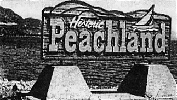 The Ogopogo Country The Ogopogo Country
Peachland
Discover Peachland 2001
Historic Peachland: a place in the heart
By Ross McDermott
(All information collected for this article was obtain from the Peachland Memories books, compiled by the Peachland Historical Society, and first printed in 1983.)
The sign outside of town welcome us to "Historic Peachland".
 But the history held by this jewl, nestled quietly in the heart of the Okanagan, is not always visible to the eyes of those who come to see. For the history that is "Historic Peachland" lies in the land, the lake and the hearts of the citizens, then and now, who chose and choose to populate what's been called the most beautiful place in the world. But the history held by this jewl, nestled quietly in the heart of the Okanagan, is not always visible to the eyes of those who come to see. For the history that is "Historic Peachland" lies in the land, the lake and the hearts of the citizens, then and now, who chose and choose to populate what's been called the most beautiful place in the world.
Long before any white settlers ever imposed upon the land, the aboriginal people of the Okanagan knew the value of the area today known as Peachland. Though they never settled in the area, it was known to be a fruitful hunting and fishing grounds.
Is was a time when the kokanee spawned up the area creeks -Peachland and Trepanier- so thick, it was said a man could walk on their backs.
In cottonwood canoes the native people would travel the lake, but not before making a sacrifice to N'ha-a-itk, the legendary lake creature Ogopogo, who was thought to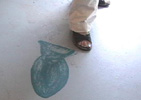 reside in and around Rattlesnake Island/Squally Point -on the east side of the lake across from Peachland. reside in and around Rattlesnake Island/Squally Point -on the east side of the lake across from Peachland.
Then, in 1810, when the Pacific Fur Co. set up Fort Astoria at the mouth of the Columbia River, Peachland and the Okanagan Valley, in all their splendor, was witness to the dawn -to the sunrise of a new era.
From this fort, employees of the fur company ventured up the Columbia River, wintered in the Okanagan Valley, and later established another fort in the Peachland/Westbank area. The fur trade had arrived and soon many feet would carve out a path through the Ponderosa pines above Peachland, and its Okanagan Lake foreshore. By 1824, the Fur Brigade Trail was established and touched down the lake level on what is today the 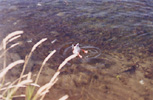 waterfront of Peachland. The Brigade Trail, as it swiftly came to be known, was a heavily travelled route of commerce until the Fraser Valley route became a more trodden path, allowing the dust to almost settle in the Okanagan. waterfront of Peachland. The Brigade Trail, as it swiftly came to be known, was a heavily travelled route of commerce until the Fraser Valley route became a more trodden path, allowing the dust to almost settle in the Okanagan.
In 1858 the dust began flying again on the Brigade Trail as gold fever, sparked by a strike on the Fraser River, brought 30,000 miners with packs, mules, equipment, a glimmer of hope, and often wonder in their eyes, winding their way up B.C.'s rivers and streams. Mining, in fact, plays an important role in Peachland's history, as it brought the early settlers to the area -among them, in 1898, the man whose been called the father of Peachland: J.M. Robinson.
Robinson had been a popular Manitoba newspaperman -founder and editor of the Brandon Times- and a former member of the Manitoba Legislature. He came to Peachland as president of the Canadian and American Gold Mining and Development Company, which operated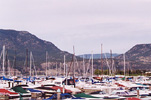 both Glen Robinson, and the Kathleen Mountain group of mines in the Peachland area. both Glen Robinson, and the Kathleen Mountain group of mines in the Peachland area.
Just one year after he arrived, Robinson was among several community members to organize and create the Peachland Town Site and Irrigation Company. They acquired 1,000 acres of lakefront land. As it turned out, his Manitoba-popularity paid off and attracted early settlers to the area. Peaches, as the town name so clearly describes, was a way of life for many early settlers. It's been said a typical fetching price for peaches in 1905 was $300 an acre, and that included having the buyer, -i.e. shipping company- thin, pick, and pack the product.
 By 1907 the need to harness the hydroelectric potential of Trepanier Creek led the municipality to seek incorporation. The creek is an important part of this quiet community. For it was this natural resource that inspired this community's early leaders to incorporate in 1909 and provided for Peachland electric lights and power. The general plan was to supply domestic water to the downtown area as well as water for a Pelton wheel about a quarter of a mile down the gorge. The piping from the newly constructed damn was split approximately 100 ft., from the source, with a 12" pipe carrying on to the powerhouse and a 8" pipe to carry domestic water. By 1907 the need to harness the hydroelectric potential of Trepanier Creek led the municipality to seek incorporation. The creek is an important part of this quiet community. For it was this natural resource that inspired this community's early leaders to incorporate in 1909 and provided for Peachland electric lights and power. The general plan was to supply domestic water to the downtown area as well as water for a Pelton wheel about a quarter of a mile down the gorge. The piping from the newly constructed damn was split approximately 100 ft., from the source, with a 12" pipe carrying on to the powerhouse and a 8" pipe to carry domestic water.
Tenders for light poles were received in July of 1907, ranging from $2.80 to $3.50 per pole.
The history of Peachland power also includes a time when this community supplied power to neighboring Westbank.
From 1946 to 1951 the Peachland power plant was more like a small cabin with a 25 kilowatt unit including a Pelton wheel, a turbine, and a governor system and it supplied power to Westbank on occasions.
Power traveled along iron wires in those days and these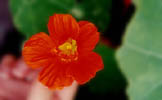 wires would, from time to time, arch and weld together. Workers would have to climb up the pole with a sledge hammer and bat the pole, literally, to get them lose. wires would, from time to time, arch and weld together. Workers would have to climb up the pole with a sledge hammer and bat the pole, literally, to get them lose.
In the same year as Peachland's incorporation, bells started ringing -telephone bells that is. An agreement was reached between the Lakeshore Telephone Company of Summerland and the Municipality of Peachland and service was provided to the homes and businesses. With that bold leap into the 20th century, the town evolved into what we see today: a visually stunning, friendly community.
Throughout the years there have been many business and industrial ventures. At one time the south side of Beach Avenue in downtown Peachland was lined with packing-houses. The famous ferries of the Okanagan would dock in the area known today as Pentowna Marina, off-load and take on freight and passengers. Peachland's waterfront played to host to such famous paddle-wheelers as The Okanagan and The Sicamous.
Sawmills also played an important role in the local economy for more than half a century, and in 1970 Brenda Mines, approximately 23 km above Peachland, began its ironore operation. From 1966 to 1971 Peachland's population more than doubled, jumping from approximately 709 to 1,446.
 Granted, there have been many changes in Peachland since those early days, but like the hearts of those who settled years ago, the people today remain friendly and accommodating to those who visit the little piece of paradise in the heart of the Okanagan. To this day, those who visit the small community are enthralled with the natural beauty and warmed by the welcome they receive from those fortunate enough to live here. For it is within the hearts of the citizens of Peachland, both present and past, and in the land which rises above the pristine foreshore, where the true historic Peachland can be found. Granted, there have been many changes in Peachland since those early days, but like the hearts of those who settled years ago, the people today remain friendly and accommodating to those who visit the little piece of paradise in the heart of the Okanagan. To this day, those who visit the small community are enthralled with the natural beauty and warmed by the welcome they receive from those fortunate enough to live here. For it is within the hearts of the citizens of Peachland, both present and past, and in the land which rises above the pristine foreshore, where the true historic Peachland can be found.
|


